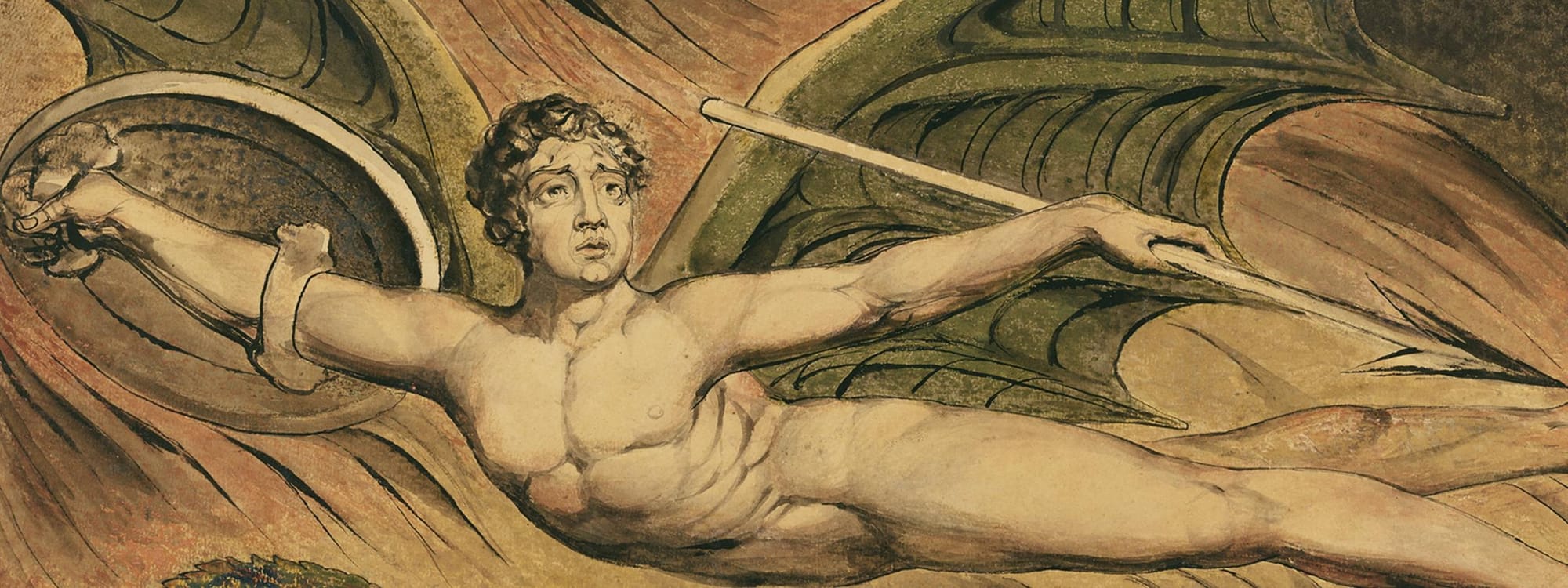WILLIAM BLAKE: VISIONARY
Getty Center
Los Angeles
Through Jan. 14, 2024
The word “prophet” gets tossed around. But in the case of William Blake (1757 – 1827), it renews itself daily. William Blake: Visionary at the Getty Center scans the lifework and fierce, radical vision of England’s — okay, the world’s — first and foremost Romantic poet and artist. From the seat of empire, he saw revolutions in France and the Americas as defiance against all forces that restrain humanity from becoming what it truly is: “the human form divine.”
At the risk of Blake-splaining, let’s state that the artist directly experienced the Imagination (capitalization his) as the engine of this creative resistance: an individual/universal resurrection rendered in illuminated books of epic prophecies within a vast mytho-system, which were cryptically codified to elude the authorities. Experiencing them up close in the Getty galleries is emotionally powerful and psychically charging.
Blake’s dialectic subsumes the following “fallen” consequences of a humanity fragmented from the loss of Imagination: rape, slavery, colonialism, sexual repression, child abuse, female/male estrangement, the reduction of labor to capital through male power, religious/political tyranny via “mind-forg’d manacles,” the “dark Satanic Mills” of industrial capitalism, and more. Because Blake’s mythology is founded in the workings of the psyche, it continually proves itself through history. Today’s repressions are market-based superegos of fascism; algorithms that colonize the mind by mining the centers of pleasure and pain; and vicious, in-your-face, land-grabbing genocides promoted by all-consuming media against Indigenous people.
Inversely, Blake also anticipated thought-advancers — from Freud and Jung to post-structuralist feminists such as Julia Kristeva to psych-shamans such as Timothy Leary and Terence McKenna — when he said that we live not in “reality” but in our mental projection of it: “[I]n your own Bosom you bear your Heaven / And Earth, & all you behold: tho it appears Without it is Within / In your Imagination.” (This passage is from Jerusalem, the longest of his epics. For a complete extrapolation of Blake’s universe into modern and postmodern eras, read John Higgs’s 2022 study William Blake vs. the World.)
The Getty compacts this sprawling vision by extracting key volumes and artworks. For our purposes, there is the confounding yet liberating book Visions of the Daughters of Albion (1793). Albion is another name for England; throughout his work, Blake personifies the nation as a “giant” mythological being. The museum offers just the frontispiece illustration and a synopsis. Here’s that and a bit more from me …
Bound together in sorrow and pain, two males and one female crouch in a cave mouth. Vegetation drips and surf crashes. A sun-eye glowers between clouds. One manacled male howls in horror, his hair vertical in shocks. Bound to him is the female, bent but determined. The other male pretzels himself in downcast shame. The three — as with all Blake figures — are hard-outlined and hard-bodied yet fluid forms.
The introductory quatrains of the poem are in the voice of the female, Oothoon: “I loved Theotormon / And I was not ashamed / I trembled in my virgin fears / And I hid in Leutha’s Vale! // I plucked Leutha’s flower, / And I rose up from the vale; / But the terrible thunders tore / My virgin mantle in twain.”
From there, the drama finds Oothoon punished by the males — with a brutal rape and vindictive jealousy — for her proud sexuality (“happy copulation”). The verse is rich in associations close to allegory: this vision is set in revolutionary America and the rape is conflated with slave traders and English colonizers: “Bromion spoke[,] behold this harlot here on Bromions bed. / And let the jealous dolphins sport around the lovely maid; / Thy soft American plains are mine, and mine thy north & south: / Stampt with my signet are the swarthy children of the sun: / They are obedient, they resist not, they obey the scourge: / Their daughters worship terrors and obey the violent.”
There it is: just as imperial powers rape continents, and torture Africans and Indigenous peoples for market domination, vein-popping male jealousy brands sex as sin to control women’s bodies.
And yet, ultimately, as the frontispiece depicts, the males are karmically haunted. It is Oothoon, the female (or female personage within us all), who, through the trauma, achieves radicalization, a victory in the “mental fight” of Blake’s universe, where revolution — always a sexual outburst — reasserts itself.






